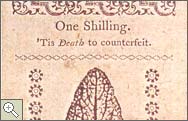
Unlike the Spanish colonists to the south, the English settlers of our original thirteen colonies found no gold or silver among the riches of their new land. Neither did they receive great supplies of gold and silver coins from Britain - money was supposed to move the other way, to the mother country, in exchange for goods. The monetary system in the colonies was "notable because it was based on thin air," says Smithsonian numismatics curator Richard Doty in his book America’s Money, America’s Story. To make up for the lack of currency, the colonists would "replicate and create, try, reject, and redesign every monetary form ever invented anywhere else."
These lessons present images of paper money from the American Revolution. Students examine the money in order to gather primary source information about the times-the Revolutionary period in general and the specific times when the bills were issued.
|
 |
 |
 |
 |

A one shilling note
|
 |
 |

Examples of the currency displayed in this lesson plan can be viewed in the Hall of History of Money and Medals at the Smithsonian National Museum of American History, Behring Center.
|
 |
 |
 |
|

